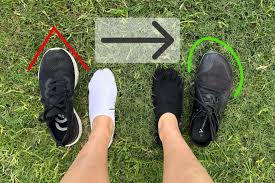Is it possible that we have been mistreating our feet for years without realizing it?
For years, the shoe industry has convinced us that we need shoes with a lot of cushioning and support. But the truth is, there are no solid foundations from science or common sense to support that idea.
«El pie humano es una obra maestra de la ingeniería y una obra de arte» – Leonardo da Vinci

🦶🏼 26 bones, 33 joints, 19 muscles, 107 ligaments
🦶🏼 3 arches, whose proper functioning depends on the correct alignment of the toes!
The design of the foot is the result of 5 million years of evolution, without shoes! If our feet were poorly made, our species would not have survived.

However, we have trapped them in rigid and narrow shoes that do not allow our feet to express their full potential or use their superpowers—like putting kryptonite on them, in the style of Superman.
Too pointy, excessively cushioned, excessively rigid…
When you think about it, it’s a real aberration.
Although the foot may initially feel comfortable, over time it ends up deforming, shifting, and losing its natural movement capability.
We demand that it function inside a structure that constrains it, prioritizing fashion, customs, or that so often repeated “need for support”.
In the end, it is the foot that adapts to the shoe—not the other way around—compromising its health and the health of the rest of the musculoskeletal system.
When you go to buy new shoes, test their flexibility in the front and in torsion.
The worst footwear you can choose is that pair of platform shoes that are completely inflexible. Those shoes are more like ski boots than sneakers.
That type of footwear causes a disconnection between your feet and the ground, nullifying the sensory feedback that is fundamental for your foot health and posture.

Some modern shoes hide a trap: the “negative heel”. The rear sinks, the ankle falls… and your posture goes with it!
The result: back discomfort and an unbalanced body without you even realizing it.
If you notice that your shoes have already lived too many adventures, it might be time for your chiropractor to check them… or to give them a well-deserved retirement!
A low heel, around 1 cm, can even be beneficial for alignment of the lumbar area. It depends on the bodies!
However, try to avoid heels over 4 cm (1.5 inches), as they can unbalance your entire posture by excessively tilting the pelvis forward.
Pay attention to how your body responds when you wear high heels: if you feel your weight shifting forward, it’s a sign that the heel is too high for you.
Many shoes come with arch support integrated into the insole. Luckily, in many cases, it can be easily removed.
Removing the insole might make the shoe feel a bit big. If so, just place a flat insole as a replacement.
Your arch doesn’t need to be held; what it really needs is stimulation, to be challenged with the natural movement of the foot when walking.
Your toes need to be able to spread and grip the ground when walking.
However, most shoes are so narrow that they squeeze the forefoot and negatively affect the foot’s natural mobility.

Finally, shoes that protect your feet without limiting, deforming, or negatively affecting the functioning of your entire body! 🥳
Minimalist shoes allow your toes to regain their natural alignment, your arches to expand freely when walking, and your muscles to work as they should.Walking barefoot or wearing minimalist shoes every day will gradually retrain your feet and provide a much healthier support for your body.
Say goodbye to discomfort, pain, and deformities. Your body will thank you!
Plus, there are now numerous options available!
In Valencia, you can try them at the minimalist shoe store: Impala barefoot
And when your feet, ankles, and other body parts are WELL accustomed and strengthened, try thinner, more flexible shoes… or even sandals!
Saltic has less pointy shoes
Xero shoes 360
«Think about the amount of time a day that you spend sitting, standing, lying down, or moving.
Together, these activities occupy 24 hours of your day. Turn them into bad habits
and the negative impacts will be more than your body can handle».
Richard GLIDDON, D.C. – ABC Trainer ™ – «UNLOCKED», 2019.
Discover how chiropractic can improve your well-being. At QuiroBalance, we offer personalized solutions to relieve pain and optimize your health.